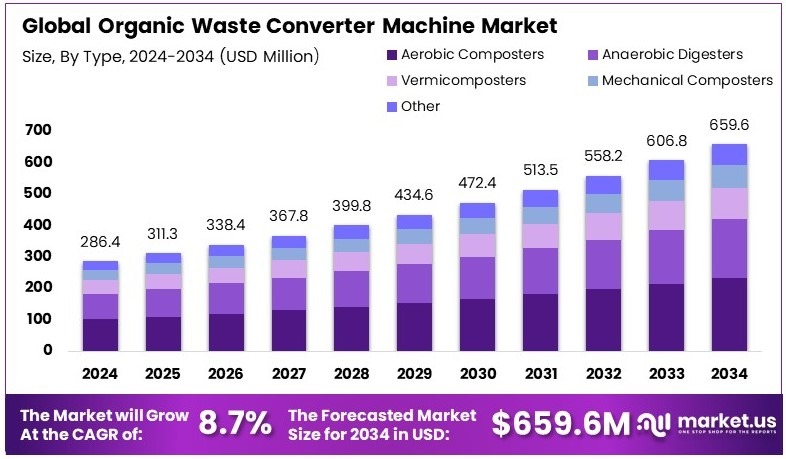Table of Contents
Market Overview
The Global Organic Waste Converter Machine Market size is expected to be worth around USD 659.6 Million by 2034, from USD 286.4 Million in 2024, growing at a CAGR of 8.7% during the forecast period.

The Organic Waste Converter Machine Market is growing fast due to rising waste management needs. Bio-mechanical composters use micro-organism-based technology to produce nitrogen-rich compost. These machines reduce organic waste volume by up to 80% efficiently. Kwik Composter is a fully automatic system for quick composting. It reduces waste volume by 70-80% in less time. Compact design saves more space compared to traditional composting. Machines without solar systems process 50 kg waste into 5-10 kg manure daily. Stainless steel tanks make machines strong and durable. The lifespan of these machines is over 20 years.
Government investment supports the use of waste converter machines. Strict waste disposal regulations increase market demand. Urban composting rules help adoption in cities. Corporate sustainability goals also drive the market forward. Organic waste converters give fast and eco-friendly waste processing. They offer high returns on long-term investments.
Growing global waste generation creates market growth opportunities. Machines meet both environmental and business needs. The market supports the circular economy in waste management. Demand will increase as sustainability becomes a priority.
Key Takeaways
- Organic Waste Converter Machine Market was USD 286.4 Million in 2024 and will reach USD 659.6 Million by 2034 at 8.7% CAGR.
- In 2024, Aerobic Composters led with 35.2% share due to high composting efficiency.
- Medium Capacity (500 kg/day to 5 tons/day) held 40.6% share in 2024 for municipal and commercial waste.
- Municipal Waste Management led applications in 2024 with 44.9% share due to strict disposal rules.
- Agriculture dominated in 2024 with 39.7% share from demand for organic fertilizers.
- North America led in 2024 with 34.8% share and USD 99.67 Billion value from recycling programs.
Market Drivers
- Rising environmental awareness is driving the adoption of OWC machines to cut landfill use and methane emissions.
- Strict waste segregation and disposal laws boost demand for on-site biodegradable waste management.
- Commercial and institutional facilities use OWC machines to manage daily organic waste and reduce costs.
- Urbanization increases organic waste generation, prompting municipal investments in treatment infrastructure.
- Circular economy efforts promote OWC machines for producing nutrient-rich compost from waste.
Challenges
- High upfront costs can discourage adoption by small-scale establishments in developing regions.
- Effective operation requires proper training to maintain efficiency and prevent breakdowns.
- Large machines need dedicated space, which is challenging in densely populated urban areas.
- Regular maintenance and part replacements increase overall operational expenses.
Segmentation Insights
Type Analysis
Aerobic composters lead with 35.2% share due to efficiency, ease of use, and suitability for municipal and residential waste. Anaerobic digesters follow for renewable biogas production, vermicomposters serve small-scale farming, and mechanical composters handle large operations despite higher costs.
Capacity Analysis
Medium capacity machines (500 kg/day to 5 tons/day) dominate with 40.6% share for their versatility in municipalities, restaurants, and industries. Small units suit homes and small businesses, while large units serve big industries and waste plants.
Application Analysis
Municipal waste management holds 44.9% share as cities seek large-scale organic waste solutions. Industrial use is next, with commercial and residential adoption growing steadily.
Take advantage of our unbeatable offer - buy now!

End-User Industry Analysis
Agriculture leads with 39.7% share for compost production in sustainable farming. Food and beverage, municipalities, healthcare, retail, and hospitality also use these machines to manage organic waste effectively.
Regional Insights
North America leads with 34.8% (USD 99.67B) driven by strong policies, high awareness, and advanced infrastructure.
Europe growth fueled by strict regulations and major investments in circular economy projects.
Asia Pacific rapid growth from urbanization, industrialization, and large-scale recycling initiatives.
Middle East & Africa expansion supported by smart city projects and eco-friendly waste solutions.
Latin America steady adoption driven by rising environmental awareness in Brazil and Mexico.
Recent Developments
- In Nov 2024, an organic waste converter machine was introduced as a key waste reduction strategy, transforming organic waste into nutrient-rich compost or other valuable byproducts. This innovation helps minimize landfill usage while promoting sustainable resource management.
- In Jan 2025, the U.S. Department of Energy’s (DOE) Bioenergy Technologies Office (BETO) and Vehicle Technologies Office (VTO) allocated $6.9 million to fund nine projects focused on local waste-to-energy solutions. These initiatives aim to support transportation energy needs while advancing eco-friendly waste management practices.
- In Mar 2024, Kochi launched an innovative organic waste plant to address growing environmental challenges in the region. The facility is designed to process large volumes of organic waste efficiently, reducing pollution and contributing to a cleaner urban environment.
Conclusion
The Organic Waste Converter Machine Market will reach USD 659.6M by 2034 at 8.7% CAGR, driven by waste regulations, sustainability goals, and urbanization. Aerobic composters, medium-capacity units, and municipal use lead, with North America dominant and Asia Pacific growing fastest. High costs remain a challenge, but government support fuels adoption.
Discuss your needs with our analyst
Please share your requirements with more details so our analyst can check if they can solve your problem(s)



